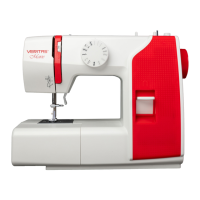21
Matching needle/ fabric/ thread
Please Note:
- Ingeneral,nethreadsandneedlesareusedforsewingnefabrics,thicker
threads and needles are used for sewing heavy fabrics.
- Always test thread and needle size on a small piece of fabric which will be used
for actual sewing.
- Use the same thread for needle and bobbin.
- Useastabilizerorplaceabackingforneorstretchyfabrics,andselectthe
correct presser foot.
- It is recommended that a 90/14 needle should be used when embroidering on
heavyweightfabricsorstabilizingproducts(forexample,denim,puyfoam,etc.).
A 75/11 needle may bend or break, which could result in injury.
- Fortransparentnylonthread,alwaysuseneedle90/14-100/16.Thesame
thread is usually used for the bobbin thread and upper threading.
NEEDLE
SIZE
FABRICS THREAD
9-11(65-75)
Lightweight fabrics-thin cottons,
voile, serge, silk, muslin, Qiana,
interlocks, cotton knits, tricot,
jerseys, crepes, woven polyester,
shirt & blouse fabrics.
Light-duty thread in cotton,
nylon, polyester or cotton
wrapped polyester.
11-14(80-90)
Medium weight fabrics-cotton,
satin, kettleclote, sailcloth,
double knits, lightweight
woollens.
Most threads sold are
medium size and suitable
for these fabrics and
needle sizes.
Use polyester threads on
synthetic materials and
cotton on natural woven
fabrics for best results.
Always use the same
thread on top and bottom.
14(90)
Medium weight fabrics-cotton
duck, woolen, heavier knits,
terrycloth, denim.
16(100)
Heavyweight fabrics-canvas,
woolens, outdoor tent and
quilted fabrics, denim, upholstery
material(lighttomedium).

